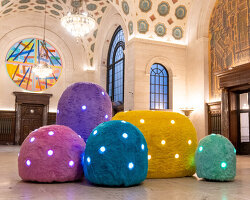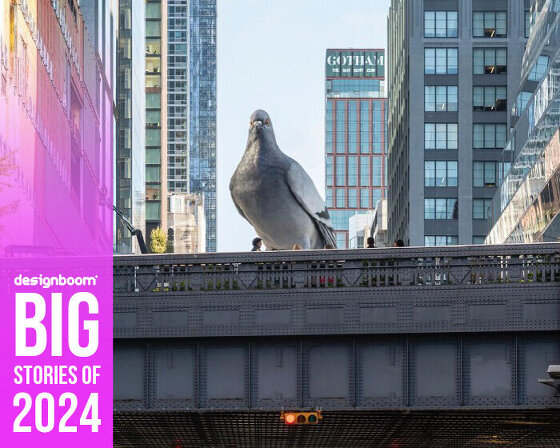in the time of ancient greece in elusias, initiates to the cult of demeter and persephone would enter a great hall known as the telesterion. here they experienced the elusian mysteries, a series of ceremonies that would become some of the oldest, most sacred and most secretive rites in greek history. as part of the 2017 day for night festival in houston texas, artist bradley g. munkowich (aka GMUNK) teamed up with long time collaborators VT pro design to present ‘TELESTRON’, a severely modern reimagining of the most ancient of immersive experiences, featuring two unlikely robotic protagonists.
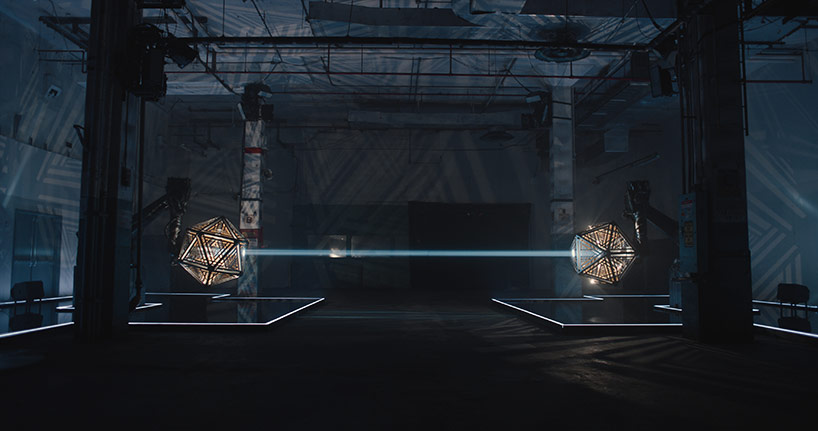
the elusian mysteries were some of the most sacred rites in greek history
all images courtesy of the artists
located inside the city’s historic houston post building, viewers are guided into vast chamber dominated by a pair of kuka mechanical arms (more commonly found working on assembly lines), mounted on two separate pools of water. each armed with a beam of light and framed by neon, the ensuing exchange between the two giants is something between conversation, combat and choreography, as lights, sound and sheer physical scale combine to create an experience unlike any other.
captured here in a stunning short film, TELESTRON is like something from a robot’s fever dream, where the most modern of technologies reenacts one of humanity’s oldest rituals. accompanied by a soundscape that is at times both rousing and ethereal, the effect is that of being granted audience to something supernatural—a robotic ballet with one foot in the future and one in the distant past.
recently, designboom caught up with GMUNK and VT pro design to chat about the challenges associated with a project of this scale, the relationship between art and technology, and the joy of working with 15 foot tall robots,
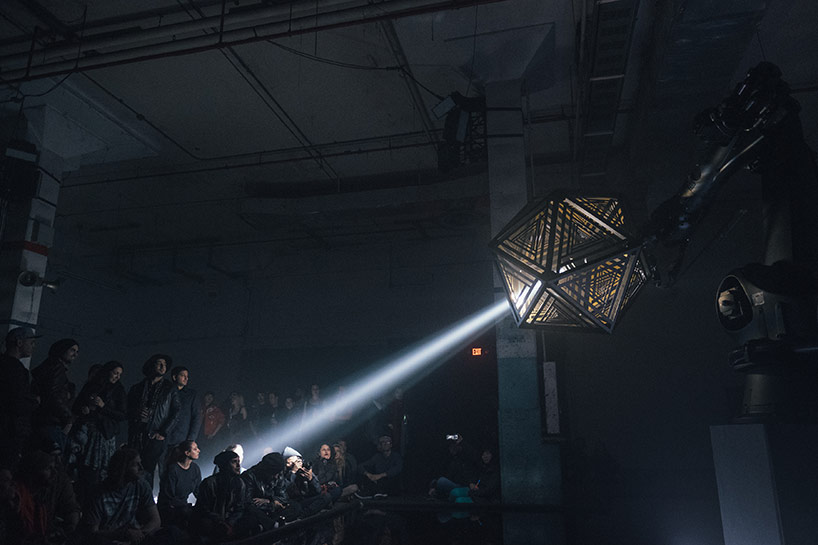
viewers were guided into vast chamber dominated by a pair of kuka robotic arms
DB: how did this collaboration come about? who initiated the idea for the project, and why day for night festival?
michael fullman (VT pro design): this is our second year at day for night festival. we just really wanted to come back because it’s such a unique festival in that some of the best AV art in the world is featured, and as the community of artists present is just incredible.
we had started on the project in march of 2017. after years of collaboration with GMUNK—including a big robotics project early last year called tecnicontrol—we thought that it would be a really fun one for all of us to jam on together. we kicked it off with working with our friend and concept writer stephen marshall, then went into a big deep dive where we spent a day storyboarding the show with miniature toy robots on a kitchen table for 12 about hours—all over a giant map of the space that we drew out.
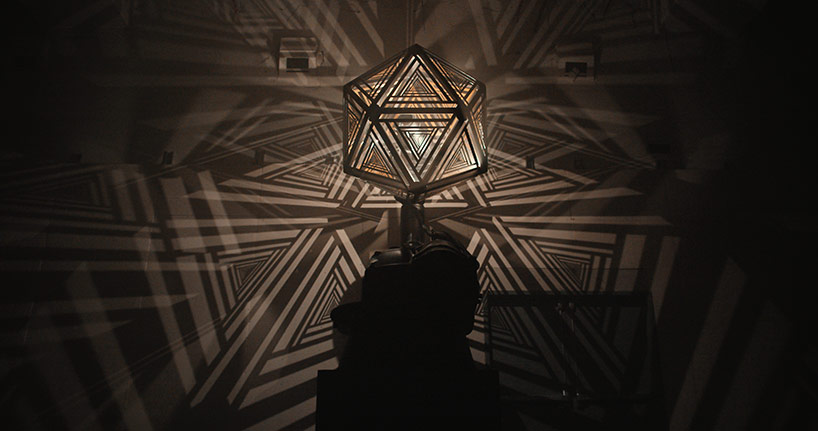
a robotic ballet with one foot in the future and one in the distant past
DB: tell us a bit about the core concept behind telestron. where did the idea come from, and what were you setting out to try and achieve? how does one begin on a project like this?
bradley g. munkowitz (GMUNK): we wanted to create a theatrical piece that felt immersive and all-encompassing—a total takeover of the senses. the core concept of telestron was that it was recreating one of the ancient world’s most sought-after immersive experiences—essentially all the attendees were taking part in a sacred ritual. this ritual was originally housed in a darkened chamber that was, in the ancient greek festival at eleusis, called the ‘telesterion’, which we adapted to telestron. this ritual was intended to ‘harness the spiritual forces of nature to create a transformative experience’.
we then got specific about what forces of nature we wanted to portray—and chose the diurnal cycle as our informing palette. we loved the poetic symmetry of the cycle being a day for night progression, and also how it influences the seasons and the positioning of the sun, which we assigned as our primary light source. we then designed each season of the cycle, which focuses on the time of year, the position of the sun, and how that affects the symbolism and character of the light. all of which were controlled by the ‘lantern bearers’ which were the robotic conductors, and were imbued specific personalities and behaviours to accurately represent the character of the light.
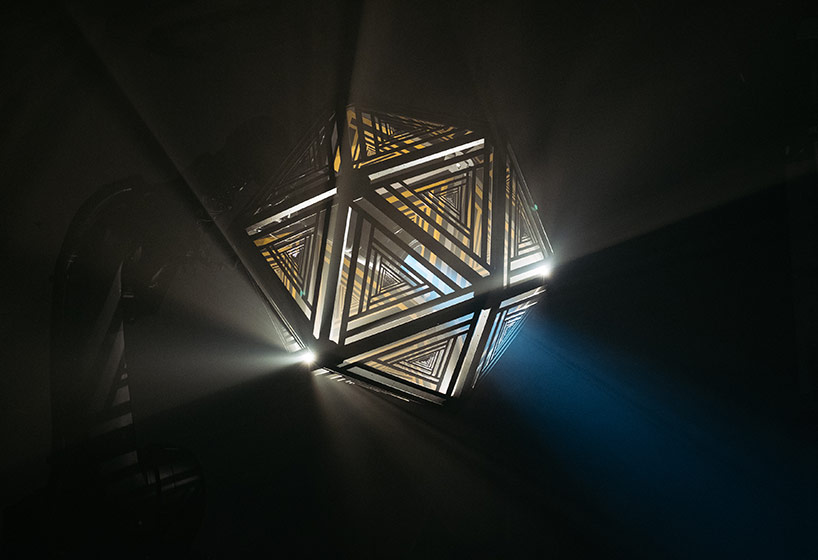
‘we wanted to create a theatrical piece that felt immersive and all-encompassing—a total takeover of the senses’
DB: the robots are absolutely the stars of the show here; how did you approach the challenge of imbuing such personality into these giant metal arms?
MF: one thing that is so special about working with robots is finding ways to break them out of their norm. they are these giant, complicated physical specimens that were meant to repeatedly accomplish similar tasks over and over. in working with them we wanted to imbue them with personality and a character-driven presence. we started every act with a ‘hero’ pose in the beginning, and a ‘hero’ pose in the end. that way we had these powerful, monolithic key moments that the robots would be journeying towards—but in the process could focus on how they got to these poses and explore their journey towards them.
I think that we approached every act not only thinking about how the robot was moving but also why it was moving, at points we wanted to make them seem quick, weightless and free, but at other points we wanted them to seem labored and exhausted with their weight and task. we were very driven by some key characteristics that we gave to the robots in every act, that supported the concept and the various seasons of the performance.
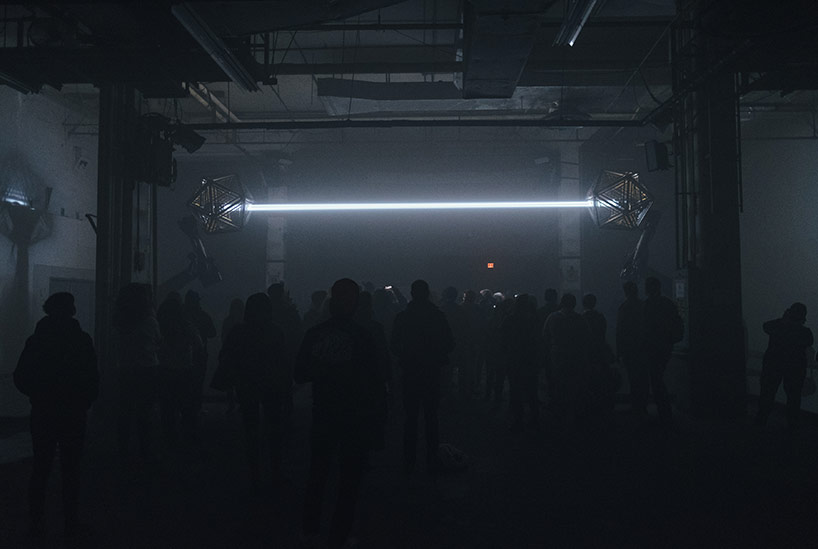
‘we approached every act not only thinking about how the robot was moving but also why it was moving’
GMUNK: another way that we were really challenged is by how they manipulated the light. in each act we would be looking at the personality of each robot, and how it would communicate the light with that personality in mind. in act IV for example, one robot is searching for the other in a night scene, and using its light to illuminate what it is trying to find. this opened us up to such a weird abstract way of thinking about these robotic conductors as much more than machines and helped to break the boundaries of the mechanical motion norms you always see them doing.
DB: we’re seeing a lot of artists getting excited about the juncture between art and robotics, and the possibilities that can be explored within that relationship. what drew you to the idea of having robots as your protagonists, and were there any drawbacks to this?
MF: we’ve been working with robotics for a few years now and every time we use them we learn something totally new that we weren’t even thinking about. in our process I think we were drawn to giving personality and relationship to these giant seemingly mindless objects. a lot of our work has to do with light, and we started going down the path of different ways that robots could manipulate light, whether it was a source that they were physically moving or a source that they were moving to and interacting with.
I think that every time we use robots we find something totally new and different that we didn’t think about, and we’re just starting to scratch the surface of the possibilities, it’s very inspiring.
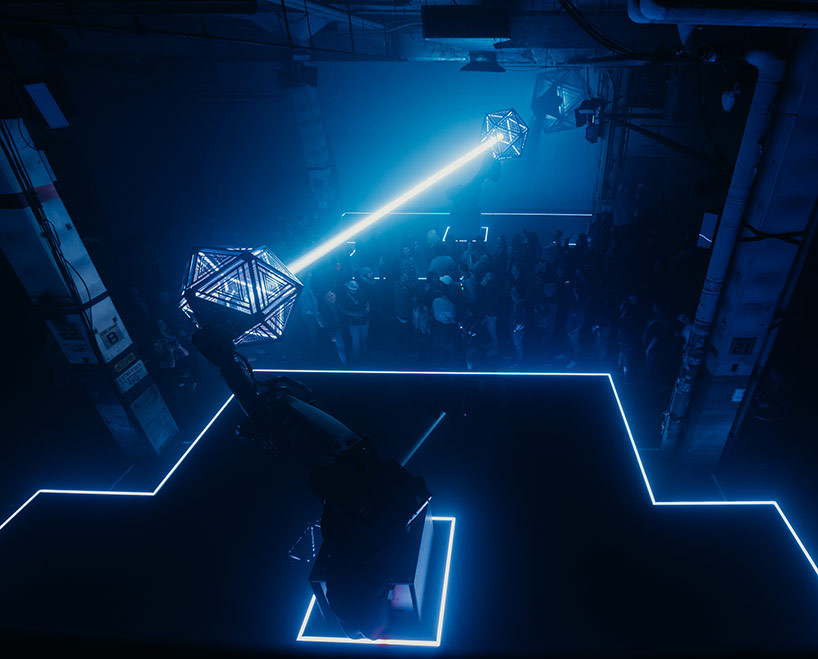
each ‘act’ of the performance begins in a hero pose…
image by theo civitello
GMUNK: I think for me it’s all about the scale of these things—as these bots are about 15 feet tall when fully extended upward. utilizing these machines at such a scale, while creating large-scale volumetric lighting using geometric gobos was a very inspiring canvas to play on, mostly because it’s so physically imposing.
we also knew crafting an amazing score (by keith ruggiero of soundsred) and staying true to our tight concept to tie it all together would, as a result, have such a profound impact on the audience. seeing it live is a completely different experience than on the internet, mostly because of the scale and sonic presence, and how industrial and textured the space we put them in was as well.
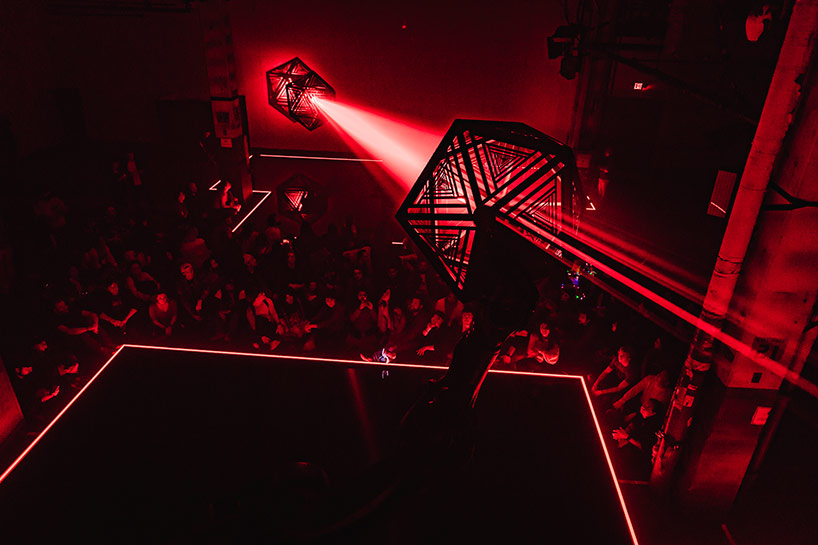
…and ends in one
image by charles reagan hackleman
DB: what were some of the big challenges you faced while working on telestron?
MF: working with all the different elements in this piece all presented individual challenges that were unique and sometimes totally unexpected. the biggest challenge being the management of all the cabling to control the moving light, pixel tape, and individual LEDs in our icosahedron. during our testing and install we kept having to find the perfect amount of slack vs. tension to complete some of our really complicated moves. we ended up for hours just having to run the entire seven minute show at low speed and constantly checking the cable wrap for tension. in the end I think we ripped the assembly out three times, sliced a power cable once, and blew out some of the LEDs on our first test.
GMUNK: I think one thing that was surprisingly difficult for us was coming up with the pattern for our geometry. we probably went through 25 different variations in 3D before eventually just drawing out patterns on cardboard until it felt right and we ended up at our design. it was totally stumping us for the entire length of the project and we finally put it to bed just a few weeks before our pre build in the studio.
but honestly, I think the most difficult part was embracing the scale and impact of it all—how the robots and light would take over the space. you can’t tell from a previous render exactly what it’s going to be—you can’t really imagine the physicality and sensory takeover by looking at it on a computer screen.
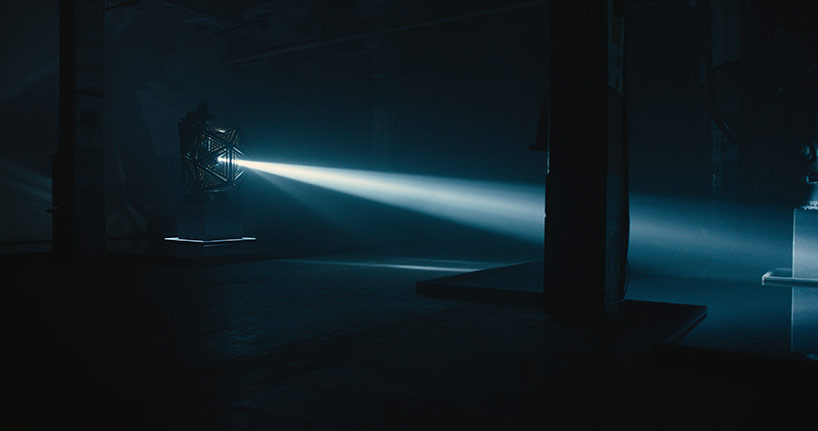
each arm was surrounded by a pool of water, which helped in keeping onlookers away from the machines
DB: telestron is an incredibly theatrical piece, and even though a definite story might not clear, narrative and atmosphere is very much present. how much of a consideration was storytelling and worldbuilding in this piece?
MF: when we first started working on the project we were definitely way into the idea of building a world that the robots occupied, plunging the audience into darkness and then pulling them back out of it through the changing volumes of light. we drew so much of this world from the physical location we were in.
the houston post building is crazy, confusing, kind of like a time capsule from the past, and it really added to the user journey just by being present in that space and the feeling that it gave us. in the past we have always wanted to tell a story through some of our works, but now I think the story is meant more for guiding us through our own creative process and then letting the audience grab parts of the narrative that they individually relate to.
one of the best parts of seeing telestron live was talking to people after they watched it and hearing what parts of the story they each individually walked away with. at the beginning of projects we always start with a general idea that we feel really passionate about, and then we start this manic back and forth exchange of ideas, visual research and exploration. together, we often feel so strongly about what we’re doing and how we’re doing it, iterating until we can see it in our heads and communicate where the world takes us.

the event was presented inside the houston post building
GMUNK: how we have been working together over the past few years is using a ton of research, reference and creative development at the very beginning of a project to guide the show and performance mechanics, and those initial phases of the project are all world building and high-concept development.
first, we start with a very basic seed concept usually conceived in an unusual setting under a particular cognitive enhancement. for this one, we knew from the beginning that we wanted to capture various light sources shot through a geometric object held by a robot – that was the spark at the most fundamental level.
then we wanted to answer all the questions – what does the geometry represent? what does the light represent? who are the robots – what are they trying to communicate? in the end, we ran with the ancient mythological story of a sacred chamber called the telestron, where a ritual would occur to harness the spiritual power of nature to create a transformative experience. I think a lot of the work we do is homage, and to take inspiration from an event so ancient and put a modern spin on it was the perfect narrative thread for us to explore.
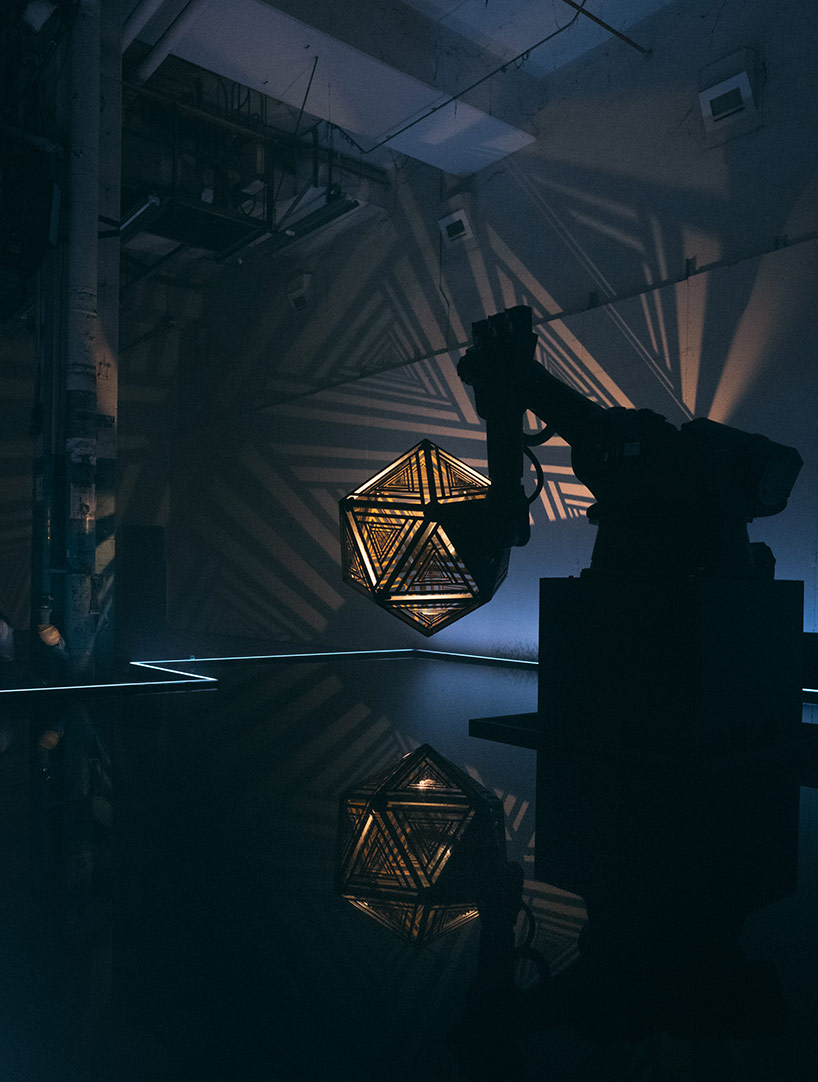
‘a lot of the work we do is homage, and to take inspiration from an event so ancient and put a modern spin on it’
DB: let’s get technical: there’s obviously a lot going on under the hood of a project of this scale. can you explain a little about some of the technologies used in realizing telestron, and how these impact the final product?
MF: starting from the ground up, telestron involved a couple of different key factors. our fabrication and physical production, electronics, control systems, etc. the two robots and their risers, and then the timeline programming of the show.
attached to the robots were our icosahedron shapes that we engineered and designed in house. they consist of a few different elements, the frames themselves were built with channels on the interior that let us sink led pixel tape into the complete geo. we then hid that pixel tape with frosted gray diffuser frames. in each vertex we also had a really bright LED cob which we wired into individual dimming control. then finally we had our moving light in the interior of the shape which allowed us a focusable and movable light source in the shape to get our natural texture through its faces.
from a control side we would animate all of the robot moves in 3D and then load those paths onto the robots controllers. from there our team built a master control system in touch designer that triggered the robots, controlled the led pixel tape, and sent out a master timecode clock that was then being read by our lighting console as well, which we used to program the two moving lights, and the room lighting as well.
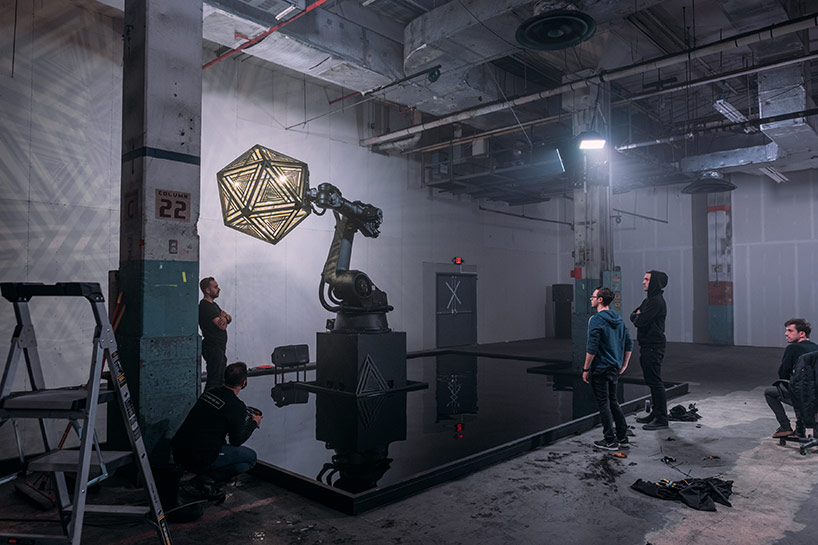
all of the robots’ paths were first animated in 3D, then loaded onto controllers
DB: experimenting with light and colour and the manipulation of these elements is something that features heavily in your work. can you speak about the relationship between these in telestron, and how your experience of other work informed this project?
GMUNK: funny you say that, because almost all of my work featuring light and colour and the manipulation of those elements was done in collaboration with VT pro. we’ve been working together for almost 8 years—it was in fact michael himself who first opened my eyes to how sequenced lighting could be used in a live-action performance with the 2011 ‘flash on the beach’ conference titles.
from that project onward I was hooked and went into a massive exploration of the medium, all the way through projects like the adobe logo remix, the windows 10 desktop, truecar, box, the chamber, eric prydz generate, car vs drones etc – all of which always had a particular light source or material involved as a major visual element.
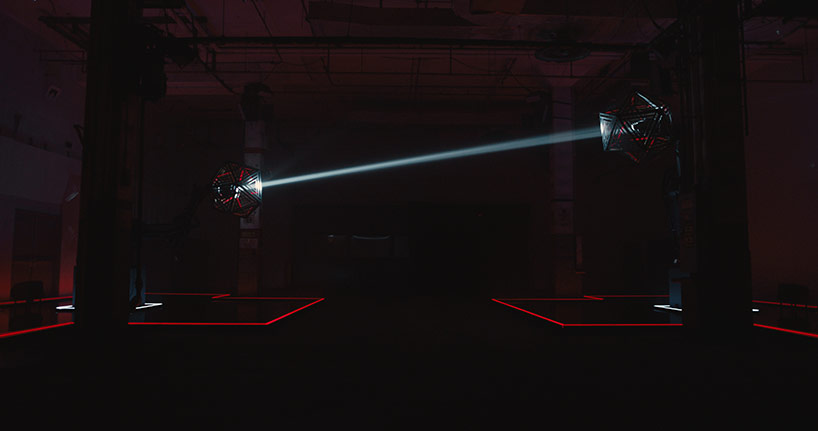
GMUNK and VT pro design have collaborated together for almost 8 years
with this project in particular, we wanted to take what we learned from the robotics work of previous projects like box, audi a3 sportback and tecnicontrol®, but instead of using robotics with projection and/or LED panels, we wanted to use robotics coupled with volumetric light sources and highly detailed shadow casting—which was a very appealing combination of visual sources because they occupied so much physical real-estate; it’s definitely the most preferred pairing of light and physicality from anything else I’ve done yet.
I then brought to the project what I’ve learned in the live-action realm and applied it to the performance film we made. however, to be honest, nothing can even come close to equaling the visual impact of seeing this thing live—it was so immensely powerful and I can’t stress enough the impact of scale. we all realize this and will be working very hard to bring these types of robotic light shows to wider audiences, so stay tuned…
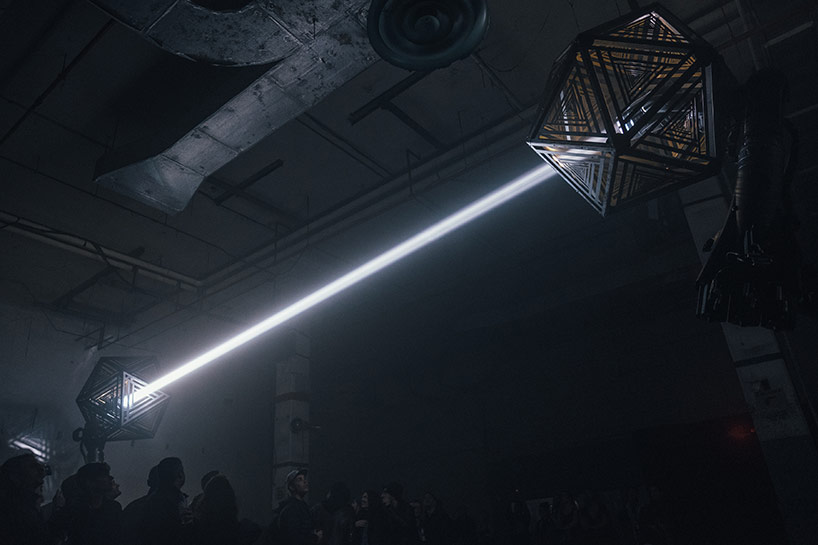
‘nothing can even come close to equaling the visual impact of seeing this thing in live’
DB: what’s next for GMUNK and VT pro design respectively? any projects on the radar you’d like to share with us?
MF: we’re always playing with new ideas, concepts, and technologies, right now we have a couple projects hitting the road but there is always something fun coming up. GMUNK and I always have proposals and opportunities in the works, but besides that we’re always talking about crazy shit and finding the new sparks.
GMUNK: we work so hard man—there’s always at least 5 projects going on simultaneously, either collaborative ones between us, passion projects for research and artistic expression, long-term permanent installations, or fast and furious commercial projects. personally, I just updated and redesigned my personal website with 8 new projects – it feels so good, and makes me even hungrier to keep publishing fresh new works and staying laser focused on keeping busy.
as a creative you have to identify the peaks and valleys of energy and stimulation—when there’s a peak, you have to maximize it and stay as productive as possible, and a lot of efficiency is achieved through collaboration and delegation. thankfully, my inner circle of creative collaborators make sure I don’t get caught in the valleys for too long.
project info:
production design: VT pro design
creative direction: michael fullman, bradley g munkowitz
touch designer programming: matt wachter
lighting design: gabe fraboni
composer: soundsred
concept writer: stephen marshall
technical design: harry souders, jack gilmore
production management: hayk khanjian, nico yernazian
robot animation & previs: jordan ariel, akiko yamashita
design assistant: david gao
cinematographers: andrew curtis, aaron marcellino
editor: jordan ariel
colorist: billy hobson
robots (547)
PRODUCT LIBRARY
a diverse digital database that acts as a valuable guide in gaining insight and information about a product directly from the manufacturer, and serves as a rich reference point in developing a project or scheme.


